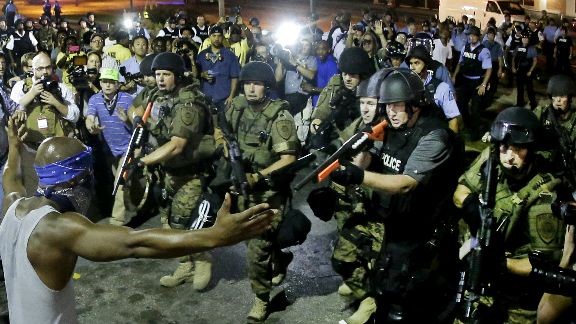Feel beauty supply, post 7
The sublime body of Michael Brown

As I noted at the start of my stint here in “Commentary,” when I was assigned to teach 18th century and Romantic aesthetics this past spring, I found the task daunting. Why teach the ideas of these dead white men at a time when the news every night talked about the deaths of unarmed black men at the hands of white police? As my class and I rehearsed the ideas of Edmund Burke, though, I began to see that one argument for reading aesthetics is to understand the long history of white supremacy’s rhetoric and how it has infiltrated our everyday thought and speech.
For me the most satisfying day of teaching occurred when I was able to put Edmund Burke in dialogue with Darren Wilson, the officer who shot and killed Michael Brown in Ferguson, MO. Wilson’s rhetoric in his grand jury testimony was easy to place within the history of the western sublime. In the police officer’s account of his struggle with Brown, Wilson described the unarmed teenager so: [Brown ]"had the most intense aggressive face. The only way I can describe it, it looks like a demon, that’s how angry he looked." The strange and confused appearance of the pronoun “it” and Wilson’s use of the noun “demon” were the things that I, in typical English teacher fashion, became obsessed with when Wilson’s statements were first released. What did these words mean in reference to Wilson’s understanding of Brown’s being? Did Wilson really think Brown was so monstrous, or was he a clever poet, who knew calling a black boy “it” and “demon” would play into the fears of white America and garner sympathy for his shooting of the unarmed teenager?
As I told my students I don’t believe Darren Wilson or Michael Brown had ever read Edmund Burke, but they didn’t have to. This notion of blackness as a sublimity capable of overthrowing white male authority is an idea our culture hasn’t escaped and Burke’s text, as I wrote previously, is simply one of our culture’s finest examples of white fear of the black body. When Darren Wilson calls Michael Brown a “demon” when he refers to the young man as “it,” Wilson is inscribing himself into western literature with a trope not unlike the one Burke used in his aesthetics that aimed to conceptualize western imagination itself.
Wilson’s use of the term “demon,” his figuration of Michael Brown’s person as extra-human, connects his Ferguson testimony not only to Burke’s conception of Blackness as threat, but also to an older tradition of the sublime. In Longinus’ On the Sublime believed to be either from the first or third century, the author identifies sublimity in the rhetoric of oratory. Where Burke locates the sublime as a function of the affects, Longinus locates it as an effect of words. As a guide book for rhetoriticians his treatise is filled with examples, most of which have one thing in common with Darren Wilson’s use of the term “Demon:” sublime rhetoric often figures an earthly order threatened by a greater extra-human cosmic order. Longinus gives us examples from classical literature where gods break through the heavens to invade the earth, or humans reach great heights in the sky to challenge the gods. Sublimity for Longinus, it seems, occurs when the boundaries between earth an another cosmic order are blurred, when the border of a seemingly distinct sphere is crossed. When we consider Wilson’s testimony as part of a long literary tradition that snakes through Burke and Longinus, we understand that blackness has been viewed by the white hegemonic order as an extra-human threat to humanity. We can conjecture that this racial imaginary is at least one reason whites so quickly pull the trigger on unarmed bodies. For the white imagination, the black body already possesses a power beyond the merely human, and for this reason it is always seen as a threat to the white, earthly order.
FEEL BEAUTY SUPPLY